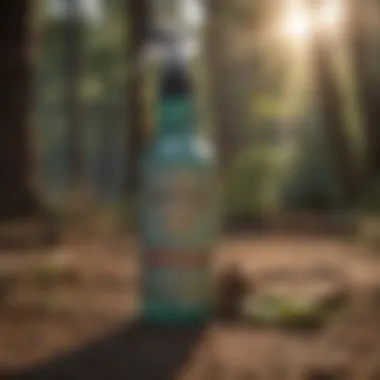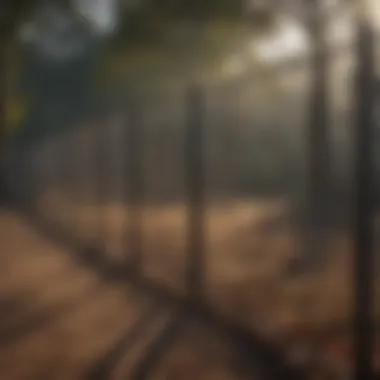Effective Possum Repellents: A Comprehensive Guide


Preventive Pest Control Strategies
When it comes to keeping possums and other pests at bay, preventive measures play a crucial role in ensuring a pest-free environment. Starting with house exterior protection, it is essential to inspect and seal any cracks or openings that could serve as entry points for possums. Clearing debris such as fallen leaves and branches is also vital to eliminate hiding spots for these nocturnal creatures. Additionally, implementing measures to prevent pests from entering your home, such as installing mesh screens on windows and doors, can be highly effective.
In terms of yard maintenance, establishing essential routines like regular mowing of lawns and trimming overgrown vegetation not only enhances the aesthetic appeal of your yard but also deters possums and other pests from taking up residence. Furthermore, utilizing methods like natural pest-repelling plants and environmentally friendly pest control products can help in maintaining a yard that is unwelcoming to these furry intruders.
Maintaining indoor cleanliness is equally important in pest prevention. Expert cleaning tips and techniques, such as vacuuming regularly, sealing food containers, and decluttering areas prone to pest activity, can significantly reduce the likelihood of possum infestations. Creating a pest-resistant indoor environment by fixing leaky faucets, sealing cracks in walls, and storing firewood away from the house ensures that possums find no enticing entry points into your living space.
Another critical aspect of preventive pest control is efficient garbage disposal. Implementing proper waste management methods, such as using sealed garbage bins and regularly disposing of food waste, not only keeps your surroundings clean but also minimizes attractants for possums and other pests. Proper garbage disposal also contributes to maintaining a hygienic environment and reducing the risk of infestations.
In addition to these core preventive strategies, exploring innovative ways to safeguard your home against possums and other pests can provide added protection. This may include using ultrasonic repellent devices, implementing motion-activated sprinkler systems, or deploying natural deterrents like garlic and predator urine around the property.
Introduction
In the realm of pest repellents, possums hold a unique spot due to their nocturnal habits and voracious appetites. This article serves as a beacon of knowledge, shedding light on the importance of effectively deterring these furry creatures from wreaking havoc in human habitats. Understanding the intricacies of possum behavior is pivotal in developing formidable strategies against them. By exploring both natural remedies and commercial products, this guide equips readers with a comprehensive arsenal to protect their homes.
Possums, with their innate nocturnal habits, pose a distinct challenge to households, often venturing out under the cloak of darkness to scavenge for food and create mischief. Hence, the significance of adopting robust possum repellents cannot be overstated. From disrupting households to creating messes in gardens, the mere presence of possums can lead to untold disturbances. Therefore, this article aims to not only address these issues but also provide concrete solutions to mitigate their impact and prevent future intrusions.
Diving deep into the world of possum repellents unveils a myriad of benefits, ranging from safeguarding property to ensuring peace of mind for homeowners. By dissecting the various aspects of natural and commercial repellents, readers will gain a profound understanding of the best practices for deterring possums effectively. Considerations such as sustainability, cost-effectiveness, and non-toxicity play a crucial role in choosing the right repellent for specific scenarios.
As we embark on this odyssey through the realm of possum repellents, it becomes evident that knowledge is power when it comes to safeguarding our living spaces from unwanted wildlife encounters. By delving into the nuances of possum behavior and repellent strategies, this article aims to empower readers with the insights and tools necessary to combat possum intrusions effectively.
Understanding Possum Behavior


In this article, delving into Understanding Possum Behavior is crucial as it forms the foundation for effectively deterring these nocturnal creatures from invading spaces. By understanding possums' behavior patterns, preferences, and habits, individuals can tailor their repellent strategies to be more targeted and successful. It allows for a strategic approach that takes into account possums' instincts and tendencies in seeking food, shelter, and safety. By comprehensively exploring possum behavior, one can develop a repellent plan that disrupts their habits and discourages them from frequenting specific areas.
Nocturnal Habits
Possums are predominantly nocturnal animals, meaning they are most active during the night. These creatures have adapted to nighttime foraging and movement, making them adept at navigating in low-light conditions. Their nocturnal habits stem from a combination of evolutionary factors and environmental influences, allowing them to avoid predators and competition during the quieter hours of the evening. Understanding possums' nocturnal nature is essential when implementing repellent strategies, as these tactics need to account for their heightened activity levels during the night.
Dietary Preferences
When it comes to dietary preferences, possums are opportunistic omnivores with a diverse palate. They feed on a wide range of food items, including fruits, insects, small animals, and plants. This broad diet allows possums to survive in various environments and adapt to different food sources based on availability. By understanding their dietary preferences, individuals can manipulate food attractants and repellents to discourage possums from accessing certain areas. Utilizing this knowledge effectively can help in deterring possums without causing harm to the animals.
Nesting Preferences
Possums exhibit specific nesting preferences, opting for secluded and protected locations to build their dens. These nocturnal creatures seek out spaces that offer safety, warmth, and proximity to food sources. Common nesting sites include hollow trees, brush piles, and attics or crawl spaces in human habitation. By understanding possums' nesting habits, individuals can identify and fortify potential entry points into buildings, use repellents near favored nesting areas, and remove attractants that lure possums to set up their homes in unwanted locations. Addressing nesting preferences is a key aspect of a comprehensive possum repellent strategy.
Natural Repellents
Natural repellents play a crucial role in effectively warding off possums without harmful chemicals. In this section, we will delve into the significance of natural repellents and their benefits when it comes to deterring these furry nocturnal creatures.
Pepper Spray
Pepper spray is a popular natural deterrent that can help keep possums away from your property. This potent spray is made from capsaicin, the compound responsible for the heat in chili peppers. When possums come into contact with pepper spray, they are repelled by the strong scent and taste, deterring them from returning to the area. It is important to apply pepper spray strategically in areas where possum activity is frequent to maximize its effectiveness.
Vinegar Solutions
Vinegar solutions are another effective natural repellent to consider when dealing with possums. Possums are known to have a keen sense of smell, and the strong scent of vinegar can be off-putting to them. By mixing vinegar with water and spraying it around your property, you can create a barrier that possums are less likely to cross. Regular reapplication may be necessary, especially after rainfall, to maintain its potency.


Garlic and Onion Mixtures
Garlic and onion mixtures can also serve as natural possum repellents due to their pungent odor. Possums have sensitive noses, and the strong smell of garlic and onions can deter them from entering your garden or home. You can create a mixture by blending garlic, onions, and water, then spraying it in areas frequented by possums. This natural repellent is both safe for the environment and effective in keeping possums at bay.
Physical Deterrents
Physical deterrents play a crucial role in effectively repelling possums from your property. These methods focus on creating barriers that deter possums from entering specific areas, thus minimizing potential damages caused by these nocturnal creatures. By implementing physical deterrents, homeowners can proactively protect their gardens, crops, and property without causing harm to the possums themselves.
Fencing
Fencing is a fundamental physical deterrent that serves as a protective barrier against possum intrusion. Choosing the right type of fencing materials and height is essential to ensure its effectiveness. Possums are agile climbers, so the fencing should be tall enough and with a design that prevents them from climbing over. Additionally, inspecting and maintaining the integrity of the fence regularly is crucial to address any potential weak spots or damages that may compromise its efficacy.
Netting
Netting is another effective physical deterrent to safeguard plants and crops from possum damage. When properly installed, netting acts as a protective barrier that prevents possums from accessing fruits, vegetables, and other desirable vegetation. Using fine mesh netting is advisable to ensure that possums cannot penetrate or damage the barrier. Regularly checking the netting for any tears or gaps is vital to promptly repair any compromised areas and maintain its effectiveness.
Motion-Activated Sprinklers
Motion-activated sprinklers are innovative physical deterrents that startle and deter possums with sudden bursts of water when they enter a designated area. The sudden spray of water serves as a non-harmful yet effective way to discourage possums from foraging in gardens or approaching specific locations. Positioning the sprinklers strategically and adjusting the sensitivity settings can help optimize their functionality. Regularly checking and maintaining the sprinklers, including ensuring an adequate water supply, is essential to ensure their continued effectiveness in deterring possums.
Commercial Repellent Products
Commercial repellent products play a crucial role in the comprehensive guide to possum repellents by offering effective solutions to deter these nocturnal creatures. As possums can be persistent in invading spaces, utilizing commercial repellent products provides a reliable method to discourage their presence. These products are formulated with specific ingredients and technologies designed to repel possums without causing harm to them or the environment. Before considering the use of commercial repellents, it is essential to understand their specific elements, benefits, and considerations.
Ultrasonic Devices


One of the key commercial repellent products for deterring possums is ultrasonic devices. These devices emit high-frequency sound waves that are unsettling to possums, causing discomfort and discouraging them from staying in the area. Ultrasonic devices are non-invasive and easy to install, making them a convenient option for deterring possums without the need for harmful chemicals. When utilizing ultrasonic devices, it is important to consider their range and coverage to effectively protect the desired area.
Chemical Repellents
Another type of commercial repellent product commonly used to deter possums is chemical repellents. These repellents typically contain strong-smelling or bad-tasting substances that possums find unpleasant, leading them to avoid the treated areas. Chemical repellents can be in the form of sprays, granules, or powders, providing flexibility in application methods. When selecting chemical repellents, it is vital to choose products that are safe for both possums and the surrounding environment, ensuring effective deterrence without causing harm.
Visual Deterrents
Visual deterrents are an additional category of commercial repellent products effective in deterring possums. These deterrents leverage visual stimuli, such as lights, reflectors, or decoys, to create a hostile environment for possums. By sparking a sense of danger or unfamiliarity, visual deterrents can discourage possums from frequenting specific areas. When utilizing visual deterrents, it is essential to strategically place them in locations where possum activity is prevalent to maximize their effectiveness and create a deterrent barrier.
Creating a Repellent Strategy
In the realm of deterring possums, creating a repellent strategy plays a vital role in achieving long-term success. By carefully planning and implementing an effective strategy, homeowners can significantly reduce possum presence and potential damage to their property. To start, it is crucial to understand that possums can be persistent creatures, so a multifaceted approach is often necessary for optimal results. Combining multiple methods not only increases the chances of success but also serves as a proactive measure to prevent infestations.
When it comes to formulating a repellent strategy, one must consider the specific elements that cater to possum behavior and preferences. By assessing factors such as nesting areas, feeding patterns, and entry points into the property, individuals can tailor their approach to target possums effectively. Additionally, incorporating both natural and commercial repellents can create a synergistic effect that enhances overall efficacy.
The benefits of creating a repellent strategy extend beyond immediate possum deterrence; it also establishes a proactive framework for long-term pest management. Regular maintenance of repellent measures and periodic assessments of their effectiveness are key components of a successful strategy. By consistently monitoring the outcomes and adjusting tactics as needed, homeowners can maintain a possum-free environment and safeguard their property against potential damage.
Moreover, considering the environmental impact of repellent methods is essential in creating a sustainable strategy. Opting for environmentally friendly solutions not only protects local wildlife but also ensures the health and safety of household members. By evaluating the balance between effectiveness and eco-friendliness, individuals can devise a holistic repellent strategy that aligns with both their pest control goals and ethical considerations.
Conclusion
In this elaborative guide on possum repellents, the conclusion serves as a crucial section to reflect on the efficacy and practicality of the various strategies discussed throughout the article. As homeowners or individuals seeking ways to deter possums from their premises, understanding the importance of a well-rounded repellent strategy is paramount to achieving sustained success. Concluding this guide is essential as it consolidates the key learnings and emphasizes the significance of taking a multi-faceted approach to possum control.
One of the primary elements highlighted in the conclusion is the need for combining multiple methods of repellents to create a comprehensive and effective defense system against possums. By intertwining natural remedies like pepper spray, vinegar solutions, and garlic and onion mixtures with physical deterrents such as fencing, netting, and motion-activated sprinklers, individuals can establish a robust protection mechanism to safeguard their properties from possum infestations.
Furthermore, the conclusion underscores the benefits of regular maintenance in ensuring the sustainability of the chosen repellent methods. Possums are resilient creatures and can adapt to repellents over time, making it imperative to consistently evaluate, refresh, or modify the repellent strategy to maintain its potency. By implementing a routine maintenance schedule, homeowners can stay proactive in preventing possum intrusions and preserving the integrity of their surroundings.
Lastly, the conclusion emphasizes the importance of monitoring the effectiveness of the repellent measures employed. Regularly assessing the success rate of various repellents enables individuals to identify any shortcomings or areas for improvement in their possum control strategy. By keeping a keen eye on the outcomes and adapting their approach accordingly, homeowners can refine their repellent tactics and enhance their overall possum deterrence efforts for long-term efficacy.
In essence, the conclusion encapsulates the essence of strategic possum repellent deployment, serving as a pivotal guidepost for individuals looking to secure their premises against these nocturnal pests. By integrating a diverse range of repellent methods, maintaining consistent upkeep, and vigilantly monitoring outcomes, homeowners can cultivate a fortified defense system that effectively keeps possums at bay within a sustainable and actionable framework.



